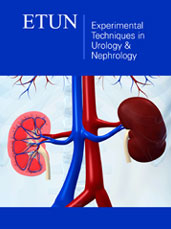- Submissions

Full Text
Experimental Techniques in Urology & Nephrology
Case of Pure Atazanavir Renal Lithiasis
Martínez AM*, Guimerà GJ, Bauzà QJL, Pieras AE, Pizá P, Costa BA, Rodriguez A and Grases F
University Hospital, Spain
*Corresponding author: Martínez AM, Urology Department Son Espases, University Hospital, Spain
Submission: October 12, 2020;Published: November 09, 2020

ISSN 2578-0395Volume3 Issue2
Introduction
A case of Atazanavir-induced renal lithiasis is presented. Atazanavir Sulfate is an HIV protease inhibitor, which is currently widely used in these patients. Atazanavir is a substance that has low solubility in water for pH values greater than 6 (it is maximum at pH 1.9 and zero at pH 6.8). Thus, the presence of Atazanavir acicular crystals in urinary sediments of patients taking this drug, as well as renal problems, has been frequently described [1-5]. The presence of these crystals in calcium oxalate stones has also been described. However, there are very few descriptions of lithiasis formed mainly by Atazanavir, such as is presented in this article.
Material and Methods
A 56-year-old male patient, treated with Kivexa, Reyataz (Atazanavir) and Norvir, with CV <37 copies and CD4 453 cells/ul. The patient went to the emergency department for left renal colic with obstructive uropathy due to radiopaque lithiasis of 6mm at the level of the sacral ureter. He underwent a Ureterorenoscopy and lithiasic fragments were submitted for laboratory analysis [6-11]. The largest solid that was submitted for its study consisted of a small whole calculus of about 2mm of diameter, as well as of several fragments of inferior sizes.
Results
Examination by electronic microscopy showed that there were objects formed by acicular crystals of about 50um, which grew in parallel arrangements, forming very compact masses. Uniformly distributed and small crystalline elements of calcium oxalate monohydrate were identified as very minor elements. FTIR spectroscopy allowed to identify the major component as crystals of Atazanavir.
Conclusion
These structures in palisade of the fragments and the characteristics of the calculi formed, demonstrate that Atazanavir achieved a high and constant supersaturation during prolonged times, which can only be explained due to patient’s pH was superior to 6 during long periods of time. Thus, urine acidification with regular urine pH, increased water intake, avoiding carbonated beverages, citrus consumption and vegetarian diets would be advisable in these cases.
References
- Louis RK, Alan WP, Scott MDW, Alan JW, Craig AP (2015) Campbell-walsh urology. 11th edn Review 45: 1283-1300.
- Lithiasis CI, Leyes M, Ribas MA, Peñaranda M, Murillas J, et al. (2015) Relationships between serum levels of atazanavir and renal toxicity or lithiasis. AIDS Res Treat.
- De Sousa B, Ponscarme D, Lapidus N, Daudon M, Weiss L, et al. (2014) Risk factors for atazanavir (ATV)-associated urolithiasis: A case-control study. Topics in Antiviral Medicine 22(1): 411-412.
- Wang LC, Osterberg EC, David SG, Rosoff JS (2014) Recurrent nephrolithiasis associated with atazanavir use. BMJ Case Reports.
- Hauner K, Maurer T, Gschwend JE, Straub M (2012) A case-report on acute renal failure due to atazanavir. Journal of Endourology 26(1): 332.
- Capocci S, Logan S, Marshall N, Youle M, Johnson M (2011) Renal stones in patients taking atazanavir. HIV Medicine 12(1): 53.
- Koblic P, Gold W, Laporte C, Zhang G, Marr T, et al. (2009) Atazanavir (ATZ)-associated urolithiasis. International Journal of Antimicrobial Agents 34(2): 69-70.
- Rockwood N, Mandalia S, Bower M, Gazzard B, Nelson M (2011) Ritonavir-boosted atazanavir exposure is associated with an increased rate of renal stones compared with efavirenz, ritonavir-boosted lopinavir and ritonavir-boosted darunavir. AIDS 25(13): 1671-1673.
- Moriyama Y, Minamidate Y, Yasuda M, Ehara H, Kikuchi M, et al. (2008) Acute renal failure due to bilateral ureteral stone impaction in an HIV-positive patient. Urological Research 36(5): 275-277.
- Estepa LM, Levillain P, Lacour B, Daudon M (1999) Infrared analysis of urinary stones: a trial of automated identification. Clin Chem Lab Med 37(11-12): 1043-1052.
- Daudon M (1999) Drug-induced urinary calculi in 1999. Prog Urol 9(6): 1023-1033.
© 2020 Martínez AM. This is an open access article distributed under the terms of the Creative Commons Attribution License , which permits unrestricted use, distribution, and build upon your work non-commercially.
 a Creative Commons Attribution 4.0 International License. Based on a work at www.crimsonpublishers.com.
Best viewed in
a Creative Commons Attribution 4.0 International License. Based on a work at www.crimsonpublishers.com.
Best viewed in 







.jpg)






























 Editorial Board Registrations
Editorial Board Registrations Submit your Article
Submit your Article Refer a Friend
Refer a Friend Advertise With Us
Advertise With Us
.jpg)






.jpg)














.bmp)
.jpg)
.png)
.jpg)










.jpg)






.png)

.png)



.png)






